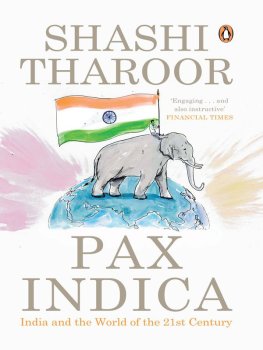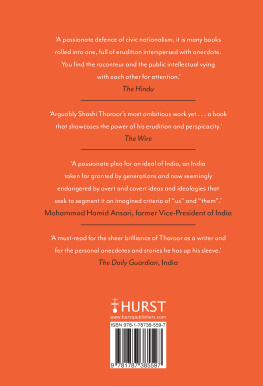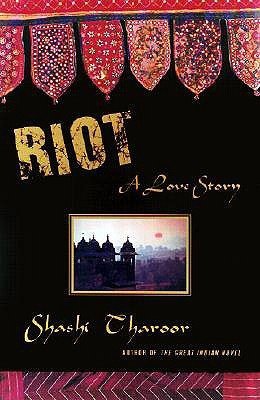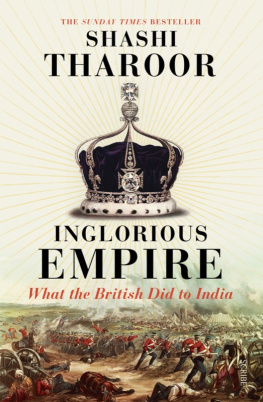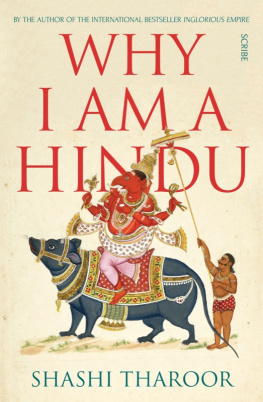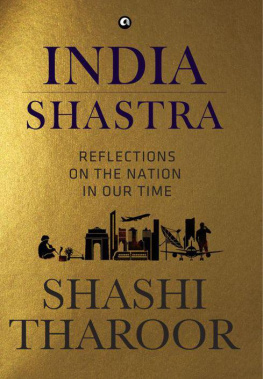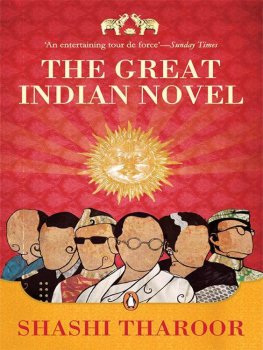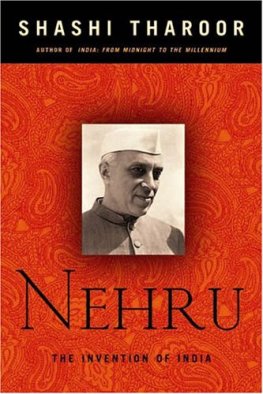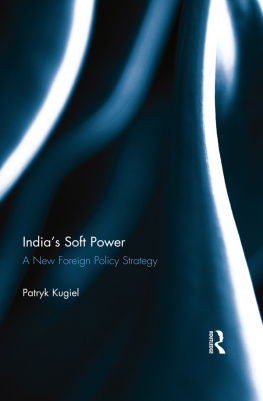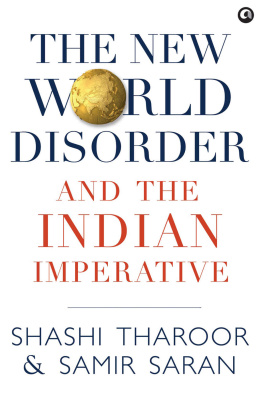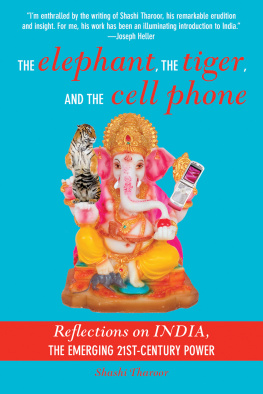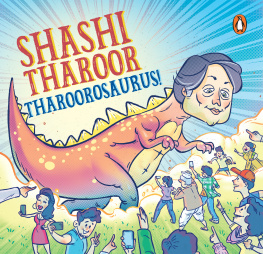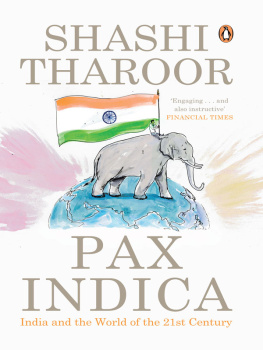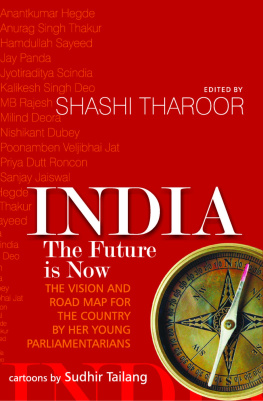Shashi Tharoor
Pax Indica: India and the World of the Twenty-first Century
Those dreams are for India, but they are also for the worldJawaharlal Nehru, Tryst with destiny speech, 15 August 1947
As a major power India can and must play a role in helping shape the global order. The international system of the twenty-first century, with its networked partnerships, will need to renegotiate its rules of the road; India is well qualified to help write those rules and define the norms that will guide tomorrows world. That is what I have called Pax Indica: not global or regional domination along the lines of a Pax Romana or a Pax Britannica but a Pax for the twenty-first century, a peace system which will help promote and maintain a period of cooperative coexistence in its region and across the world.
Chapter One Revisiting the Tryst with Destiny
At midnight on 15 August 1947, independent India was born as its first prime minister, Jawaharlal Nehru, proclaimed a tryst with destiny a moment which comes but rarely in history, when we pass from the old to the new, when an age ends and when the soul of a nation, long suppressed, finds utterance. It was an hour of darkness, too, with the flames of Partition blazing across the land, hundreds of thousands being butchered in sectarian savagery and millions seeking refuge across the arbitrary lines that had vivisected their homelands. Yet in the midst of these horrors, mingled with the joy of that sublime moment when, in Nehrus memorable words, India awoke to life and freedom, our prime minister remained conscious of his countrys international obligations. In his historic speech about Indias tryst with destiny, Nehru, speaking of his countrys dreams, said: Those dreams are for India, but they are also for the world, for all the nations and peoples are too closely knit together today for any one of them to imagine that it can live apart. Peace has been said to be indivisible; so is freedom, so is prosperity now, and so also is disaster in this One World that can no longer be split into isolated fragments. It was typical of that great nationalist that, at a time when the fires of Partition were blazing across the land, he thought not only of India, but of the world.
In a sense, this was not entirely surprising, because India had, for millennia, been engaged with the rest of the world. The north of India had witnessed a series of visitations and invasions, ranging from armed hordes of Macedonians, Scythians, Persians and Central Asians marching in through the north-west in quest of pillage and plunder to learned Chinese scholars crossing the Himalayas in the north and north-east in quest of learning and wisdom. The South, with its long coastlines, had enjoyed trade relations with the Roman Empire, the Arab lands to the west and the east coast of Africa, while extending its religious and cultural influence to the Asian countries to the east. Historical records and archaeological excavations demonstrate that Indias connections with the rest of the world go at least as far back as the Harappan civilization of 25001500 BC, which maintained extensive links with Mesopotamia. Europes history of trading relations with India is borne out in the writings of the ancient historians Herodotus, Pliny, Petronius and Ptolemy, and long precedes the colonial experience. The naval expansionism of the southern Chola and Pallava empires took Indian influences directly to Thailand, Malaya, Indonesia and Cambodia. Later, the Mughal Empire served as the centre of an Indo-Persian world that straddled both the Bay of Bengal and the Arabian Sea, and whose influence stretched east as well as west so that Thai kings named themselves after Deccani sultans and the first epic poet of Aceh (in Sumatra) was born in Surat (in Gujarat). It could indeed be argued that the India of today is the direct product of millennia of contact, trade, immigration and interaction with the rest of the world. Nehru was thus speaking as heir to this history.
Yet for two centuries before that moment, India had been unable to express its voice or exercise its place in the world. The British had usurped that right from it; when India, under colonial rule, was made a founding member of the League of Nations after the First World War, its delegation was headed by a former England cricket captain, C.B. Fry. Those who spoke for India in the world did so with Britains interests uppermost in their minds. Indias authentic voice had only been heard in those international conferences of subaltern groups where nationalists like Jawaharlal Nehru spoke for his oppressed and excluded people, or in the resolutions passed annually by the Indian National Congress on the international situation resolutions which had no discernible effect on the decision-makers in London who determined where India would stand in world affairs.
So when Nehru spoke at that midnight moment, he was speaking for a nation that had found its own voice in the world again, and was determined to use it to express a worldview radically different from that which had been articulated by Indias British rulers in previous decades. And he was doing so as a convinced internationalist himself, one who had seen much of the world in his extensive travels and was resolved to apply his own understanding of it to his newly independent nations stance in world affairs.
In the six decades since Nehrus India constituted itself into a sovereign republic, the world has become even more closely knit together than he so presciently foresaw. Indeed, as the twenty-first century enters its second decade, even those countries that once felt insulated from external dangers by wealth or strength or distance now fully realize that the world is truly knit together as never before, and that the safety of people everywhere depends not only on local security forces, but also on guarding against terrorism; warding off the global spread of pollution, of diseases, of illegal drugs and of weapons of mass destruction; and on promoting human rights, democracy and development.
Jobs everywhere, too, depend not only on local firms and factories, but on faraway markets for products and services, on licences and access from foreign governments, on an international environment that allows the free movement of goods and persons, and on international institutions that ensure stability in short, on the international system that sustains our globalized world.
Today, whether you are a resident of Delhi or Dili, Durban or Darwin, whether you are from Noida or New York, it is simply not realistic to think only in terms of your own country. Global forces press in from every conceivable direction. People, goods and ideas cross borders and cover vast distances with ever greater frequency, speed and ease. We are increasingly connected through travel, trade, the Internet; through what we watch, what we eat and even the games we play. The ancient Indian notion encapsulated in the Sanksrit dictum vasudhaiva kutumbakam (the world is a family) has never been truer.
These benign forces are matched by more malign ones that are equally global. In my time as a career official at the United Nations, I learned that the world is full of problems without passportsproblems that cross all frontiers uninvited, problems of terrorism, of the proliferation of weapons of mass destruction, of the degradation of our common environment, of contagious disease and chronic starvation, of human rights and human wrongs, of mass illiteracy and massive displacement. Such problems also require solutions that cross all frontiers, since no one country or group of countries can solve them alone.
One simply cannot forget that 9/11 made clear the old clich about our global village for it showed that a fire that starts in a remote thatched hut or dusty cave in one corner of that village can melt the steel girders of the tallest skyscrapers at the other end of our global village.

